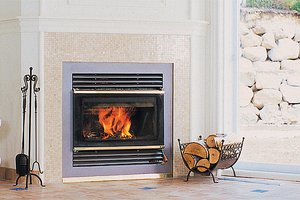
A traditional wood-burning fireplace adds warmth and romantic ambience to a home’s interior. But most are energy hogs, converting only 15% of wood’s energy into useful heat. Fortunately, new energy-efficient fireplace designs are helping wood-burning fireplaces achieve efficiency ratings of 75% or more. Fireplace inserts and gas fireplaces are even more efficient.
Energy-efficient wood-burning fireplaces
If you’re adding a wood-burning fireplace, avoid the standard design, which sends too much of your home’s heated air up the chimney. Consider these energy-efficient wood-burning fireplaces:
Glass doors work particularly well when a fire is burning down for the night and you must leave the damper open. Otherwise, glass doors block radiant heat; keep them open when your fire is blazing. Expect to pay $300 to $500 for glass doors, installed.
In California, glass or solid metal doors are required on all fireplace openings.
Energy-efficient gas fireplaces
If you want the convenience and low maintenance of a energy-efficient gas fireplace, you have two good options:
Some types of fireplaces qualify for a federal energy tax credit of up to $300 until the end of 2013. In addition, certain states may provide tax credits for various types of energy-efficiency improvements, including fireplaces.
If you’re adding a wood-burning fireplace, avoid the standard design, which sends too much of your home’s heated air up the chimney. Consider these energy-efficient wood-burning fireplaces:
- Rumford fireplaces feature a shallow box design that reflects more heat into the room.
- EPA-rated fireplaces have good performance and high energy-efficiency ratings. They are designed to pull in outdoor air for combustion, and circulate room air around the firebox to extract as much useable heat as possible. In addition, EPA-approved wood-burning fireplaces produce much less air pollution than standard fireplaces.
- Fireplace inserts are sealed metal boxes designed to fit inside masonry fireplace openings. They use outside air for combustion, and are designed to circulate and warm inside air. Inserts burn a variety of biomass fuels, including wood and pellets. Some units are rated at 80% efficiency.
Glass doors work particularly well when a fire is burning down for the night and you must leave the damper open. Otherwise, glass doors block radiant heat; keep them open when your fire is blazing. Expect to pay $300 to $500 for glass doors, installed.
In California, glass or solid metal doors are required on all fireplace openings.
Energy-efficient gas fireplaces
If you want the convenience and low maintenance of a energy-efficient gas fireplace, you have two good options:
- Direct-vent gas fireplaces, which use two-way vents that supply outside air for combustion, have energy-efficiency ratings as high as 77%. That’s better than the top gas fireplaces connected to a chimney.
- Vent-free gas fireplaces are even more energy-efficient because they don’t send exhaust outside. But they release a lot of moisture into inside indoor air.
Some types of fireplaces qualify for a federal energy tax credit of up to $300 until the end of 2013. In addition, certain states may provide tax credits for various types of energy-efficiency improvements, including fireplaces.
Read more: http://www.houselogic.com/home-advice/fireplaces-chimneys/energy-efficient-fireplaces-wood-burning-gas-burning/#ixzz3E3PZVziz
No comments:
Post a Comment